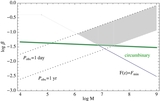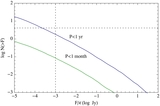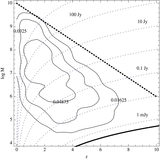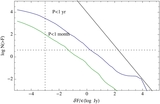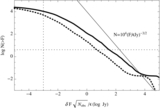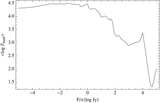Image Details
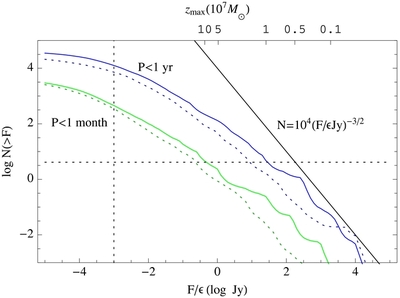
Caption: Figure 3.
Sources with orbit period modulation I: total number: at any instant of time, the number of decoupled SMBH binaries vs. average
jet flux, limiting to orbit periods within
P
min = 1 minute and
P
max = 1 year (blue and dotted blue) or 1 month (green and dotted green) over the entire sky, with flux above
F/
![]() for
for
![]() =
=
![]() radio
radio
![]() Edd the composite efficiency of the jet, using the SE (small seed, efficient accretion; dashed lines) and LE (large seed, efficient
accretion; solid lines) model of Sesana et al. (2011a). For example, for an efficiency
Edd the composite efficiency of the jet, using the SE (small seed, efficient accretion; dashed lines) and LE (large seed, efficient
accretion; solid lines) model of Sesana et al. (2011a). For example, for an efficiency
![]() = 10
−3 and target flux sensitivity 1 mJy, one to several hundred binaries are bright enough to see and have periods less than 1
year; of order one has a period less than 1 month. In the limit of infinite sensitivity, all rates must be less than the all-sky
rate (
= 10
−3 and target flux sensitivity 1 mJy, one to several hundred binaries are bright enough to see and have periods less than 1
year; of order one has a period less than 1 month. In the limit of infinite sensitivity, all rates must be less than the all-sky
rate (
![]() 30 yr
−1) times the longest time allowed (1 Myr, corresponding to the time since separation from a circumbinary disk). In the limit
of poor sensitivity, the number vs. flux scales as
F
−3/2, as usual for the nearby universe. For comparison, the solid black line is 10
4(
F/
30 yr
−1) times the longest time allowed (1 Myr, corresponding to the time since separation from a circumbinary disk). In the limit
of poor sensitivity, the number vs. flux scales as
F
−3/2, as usual for the nearby universe. For comparison, the solid black line is 10
4(
F/
![]() Jy)
−3/2. The top axis shows ticks at
z
max, the redshift at which
L
edd/4π
d
2
L
=
F/
Jy)
−3/2. The top axis shows ticks at
z
max, the redshift at which
L
edd/4π
d
2
L
=
F/
![]() for
M = 10
7
M
☉; as we assume
for
M = 10
7
M
☉; as we assume
![]() < 1, no source can be detected at higher redshift.
< 1, no source can be detected at higher redshift.
Copyright and Terms & Conditions
© 2011. The American Astronomical Society. All rights reserved.


